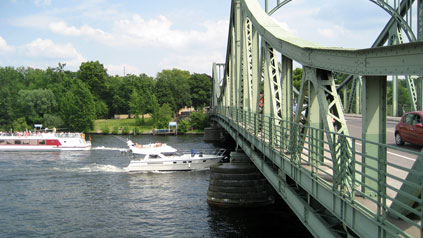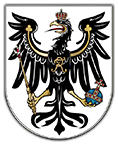
The Glienicke Bridge spans a narrow section of the River Havel between Jungfernsee and Glienicke Lake. It is considered one of the most historically important transportation links between Potsdam and Berlin. The bridge’s steel truss construction dates back to 1907, although the site has been the location of three other bridges. The immediate predecessor of today's Glienicke Bridge was a brick bridge designed by Karl Friedrich Schinkel that opened in 1837. At the beginning of the twentieth century, the bridge had to be replaced because it was too low to accommodate the Havel’s increasing ship traffic on the Havel into Potsdam.
The steel Glienicke Bridge was built by the Duisburg company Harkort. Not only was the new bridge higher, it was also wider than the Schinkel’s bridge in order to accommodate the growing automobile traffic between Berlin and Potsdam. However, the design was initially met with little enthusiasm. Conservationists protested against the demolition of Schinkel’s brick bridge, while the steel truss provided little enthusiasm for architecture critics. At the same time, the bridge quickly became one of the main thoroughfares in Potsdam. Shortly before the end of World War II, the are around the bridge was the site of intense fighting between German and Soviet troops. This fighting eventually led to its destruction. In 1945, a temporary wooden river crossing built in its place.As the bridge’s steel structure remained largely intact, the Glienicke Bridge was reopened in 1949. In subsequent years, the bridge served as a border crossing between Potsdam and West Berlin although it was closed to traffic in 1952. After the Berlin Wall was built, the border crossing was completely impassable. During the Cold War, the Glienicke Bridge was repeatedly used for the exchange of prisoners between agents and the East and the West as it was considered to be particularly easy to monitor. High-level diplomats also used the bridge to get from Potsdam to West Berlin. In 1988, three East German refugees managed to successful break through the border by truck.
Immediately after the fall of the Berlin Wall in 1989, the Glienicke Bridge was reopened to traffic. Once again serving as a transportation link between Potsdam and Berlin, the bridge is now part of the Bundesstraße (Federal Highway) 1. The bridge is a popular tourist attraction thanks to its unique design, turbulent history and scenic location. The Glienicke Bridge and the surrounding landscape are also part of a UNESCO World Heritage Site. The bridge itself remains a monument to the division of German and one of the world’s most famous former border crossings.Events in Potsdam
ticket sales
Music Festival in PotsdamThe Music Festival in Potsdam will be held again in June. This year's theme "Music and gardens" ubiquitous. So even on the opening day in June. Interesting and unique you can take guided tours and visits to many different places. For those interested there is an Opera Workshop.
TICKETSDetails about the Music Festival in Potsdam can be found here.
The concert on the eve and Night of the Palaces in PotsdamThe Park of Sanssouci and Sanssouci Palace with its terraced vineyards and the New Palace are undisputedly the most important monuments in Potsdam, therefore provides the Night of the Palaces as an excellent temporal orientation, to learn more about the state capital of Brandenburg.
TICKETSDetails about the Night of the Palaces can be found here.



